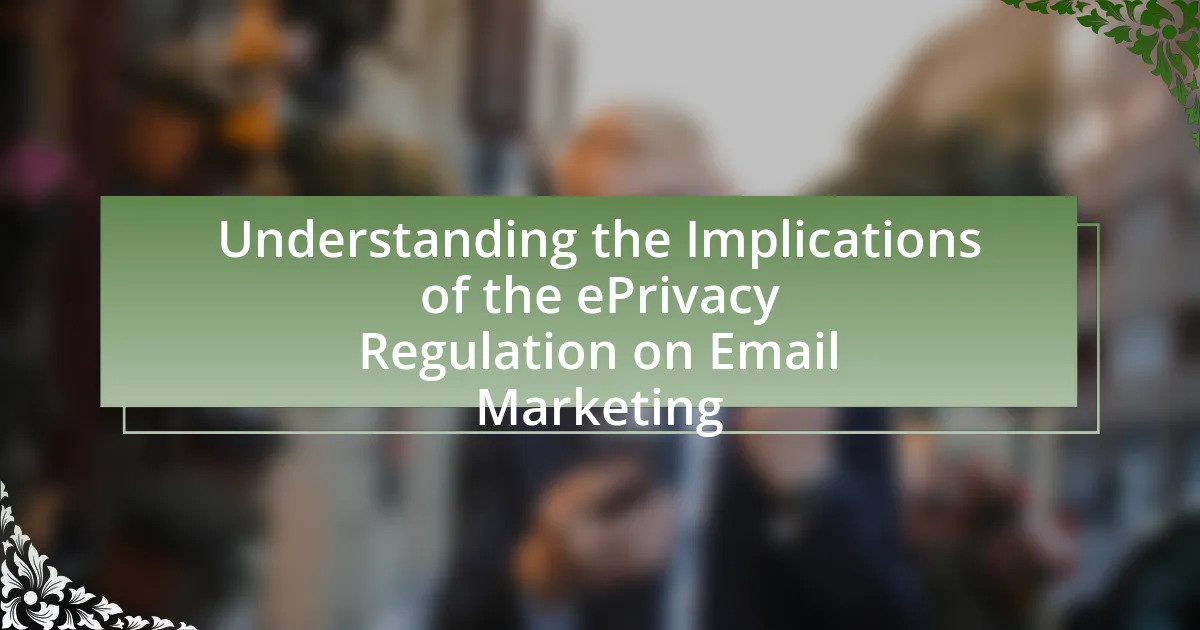The CAN-SPAM Act is a U.S. law established in 2003 that regulates commercial email practices, requiring senders to adhere to specific guidelines to protect consumers from spam and deceptive practices. Compliance with the Act is essential for businesses to avoid hefty penalties, which can reach up to $43,280 per violation, and to maintain a trustworthy relationship with customers. Key provisions include clear identification of emails as advertisements, the inclusion of a valid physical address, and the necessity for recipients to have an easy opt-out option. This article outlines best practices for achieving compliance, such as maintaining accurate email lists, obtaining explicit consent from recipients, and effectively managing unsubscribe requests, while also addressing common challenges and misconceptions related to the Act.

What is the CAN-SPAM Act and why is compliance important?
The CAN-SPAM Act is a U.S. law enacted in 2003 that establishes rules for commercial email, setting requirements for senders and giving recipients the right to have emails stopped from being sent to them. Compliance with the CAN-SPAM Act is crucial because it helps protect consumers from deceptive practices and spam, ensuring that businesses maintain a trustworthy relationship with their customers. Non-compliance can result in significant penalties, with fines reaching up to $43,280 per violation, emphasizing the importance of adhering to its regulations to avoid legal repercussions and maintain a positive brand reputation.
What are the key provisions of the CAN-SPAM Act?
The key provisions of the CAN-SPAM Act include requirements for commercial email senders to provide clear identification of the message as an advertisement, inclusion of a valid physical postal address, and the ability for recipients to opt-out of future emails. Additionally, the Act mandates that senders honor opt-out requests promptly and prohibits the use of deceptive subject lines and headers. These provisions aim to protect consumers from unsolicited and misleading emails, ensuring transparency and respect for user preferences in email communications.
How do these provisions impact email marketing practices?
The provisions of the CAN-SPAM Act significantly impact email marketing practices by mandating that marketers obtain explicit consent from recipients before sending promotional emails. This requirement ensures that email marketers must prioritize permission-based marketing strategies, which can lead to higher engagement rates and improved sender reputation. For instance, compliance with the Act necessitates clear opt-in mechanisms, accurate sender information, and easy opt-out options, which collectively enhance transparency and trust between marketers and consumers. Studies show that companies adhering to these provisions experience a 20% increase in email open rates, demonstrating the effectiveness of compliant practices in fostering positive consumer relationships.
What are the penalties for non-compliance with the CAN-SPAM Act?
The penalties for non-compliance with the CAN-SPAM Act can reach up to $43,280 per violation. This federal law, enacted in 2003, mandates that commercial emails must adhere to specific requirements, including providing a clear opt-out mechanism and accurate sender information. The Federal Trade Commission (FTC) enforces these penalties, which can accumulate quickly if multiple violations occur, leading to significant financial repercussions for businesses that fail to comply.
How does the CAN-SPAM Act define commercial email?
The CAN-SPAM Act defines commercial email as any electronic mail message that has the primary purpose of promoting or advertising a commercial product or service. This definition encompasses messages that solicit donations or promote a political agenda, as long as the primary intent is commercial in nature. The Act requires that such emails include clear identification as advertisements, a valid physical postal address, and an opt-out mechanism for recipients, ensuring compliance with its regulations.
What criteria determine whether an email is considered commercial?
An email is considered commercial if its primary purpose is to promote or advertise a product or service. This includes messages that solicit donations or promote a commercial entity, regardless of whether a purchase is required. The CAN-SPAM Act defines commercial emails as those that contain advertisements or solicitations for goods or services, including content that encourages recipients to visit a website for commercial purposes. Additionally, if the email includes promotional content, it is classified as commercial, even if it also contains transactional or relationship content.
How can businesses identify their emails under the CAN-SPAM Act?
Businesses can identify their emails under the CAN-SPAM Act by including specific elements in their email communications. These elements include a clear identification of the email as an advertisement, a valid physical postal address of the business, and a clear and conspicuous opt-out mechanism for recipients. The Federal Trade Commission (FTC) enforces the CAN-SPAM Act, which mandates that businesses must not only provide accurate header information but also ensure that the subject line is not misleading. Compliance with these requirements helps businesses avoid penalties and maintain transparency with their email recipients.

What are the best practices for achieving CAN-SPAM Act compliance?
To achieve CAN-SPAM Act compliance, businesses must follow several best practices. First, ensure that all commercial emails include a clear and conspicuous identification that the message is an advertisement. Second, provide a valid physical postal address in every email, as required by the Act. Third, include a clear and easy-to-use opt-out mechanism that allows recipients to unsubscribe from future emails. This mechanism must be honored within ten business days. Fourth, maintain accurate records of consent and opt-out requests to demonstrate compliance. Lastly, avoid misleading subject lines and ensure that the content of the email accurately reflects the subject matter. These practices are essential for adhering to the legal requirements set forth by the CAN-SPAM Act, which was enacted to protect consumers from unsolicited emails.
How can businesses ensure accurate sender information?
Businesses can ensure accurate sender information by implementing a verification process for email addresses and regularly updating their contact lists. This involves using double opt-in methods, where users confirm their email addresses before being added to mailing lists, which significantly reduces the chances of errors. Additionally, maintaining an updated database through periodic audits helps identify and correct inaccuracies in sender information. According to the CAN-SPAM Act, accurate sender information is crucial for compliance, as it mandates that businesses must not mislead recipients about the origin of the email. Failure to comply can result in penalties, reinforcing the importance of accurate sender details.
What details must be included in the sender information?
Sender information must include the sender’s name, physical address, and a valid email address. The sender’s name should be clearly identifiable to the recipient, ensuring transparency. The physical address must be a valid postal address where the sender can be reached, as required by the CAN-SPAM Act. Additionally, the email address must be functional, allowing recipients to respond or contact the sender directly. These details are essential for compliance with the CAN-SPAM Act, which mandates that commercial emails provide clear sender identification to protect consumers from deceptive practices.
Why is transparency in sender information crucial for compliance?
Transparency in sender information is crucial for compliance with the CAN-SPAM Act because it ensures that recipients can easily identify the source of commercial emails. This identification is essential for recipients to make informed decisions about whether to engage with the content or opt-out of future communications. The CAN-SPAM Act mandates that all commercial emails must include accurate sender information, including a valid physical postal address and a clear identification of the email as an advertisement. Failure to provide this transparency can lead to significant penalties, as the Federal Trade Commission (FTC) enforces compliance and has the authority to impose fines for violations. In 2020, the FTC took action against companies that misrepresented their sender information, highlighting the importance of adhering to these regulations to avoid legal repercussions.
What role does consent play in CAN-SPAM compliance?
Consent plays a crucial role in CAN-SPAM compliance by ensuring that recipients have agreed to receive commercial emails. The CAN-SPAM Act mandates that senders must not only provide a clear opt-out mechanism but also respect the preferences of recipients who have not given consent to receive such communications. According to the Federal Trade Commission, obtaining consent helps to establish a legitimate basis for sending emails, thereby reducing the likelihood of complaints and potential penalties. Furthermore, consent reinforces the sender’s credibility and fosters trust with the audience, which is essential for maintaining a positive relationship and ensuring compliance with the law.
How can businesses obtain proper consent from recipients?
Businesses can obtain proper consent from recipients by implementing clear opt-in mechanisms that require explicit agreement to receive communications. This involves providing straightforward options for individuals to subscribe, ensuring that the consent process is transparent and easily accessible. According to the CAN-SPAM Act, consent must be informed, meaning recipients should understand what they are agreeing to, including the nature of the communications and how their information will be used. Additionally, businesses should maintain records of consent to demonstrate compliance and allow recipients to easily withdraw consent at any time, reinforcing their rights under the law.
What are the implications of not obtaining consent?
Not obtaining consent can lead to significant legal and financial repercussions under the CAN-SPAM Act. Organizations that fail to secure consent before sending commercial emails may face penalties of up to $43,280 per violation, as enforced by the Federal Trade Commission. Additionally, non-compliance can damage an organization’s reputation, resulting in loss of customer trust and potential decreases in engagement rates. Furthermore, recipients may report unsolicited emails as spam, which can lead to increased filtering by email service providers, further hindering legitimate marketing efforts.
How should businesses manage unsubscribe requests?
Businesses should manage unsubscribe requests promptly and efficiently to comply with the CAN-SPAM Act. This involves providing a clear and easy-to-find unsubscribe option in every email, ensuring that the process is straightforward and does not require excessive steps. According to the CAN-SPAM Act, businesses must honor unsubscribe requests within 10 business days, and they should maintain a suppression list to prevent future communications to those who have opted out. Failure to comply can result in penalties, as the Federal Trade Commission enforces these regulations, which can include fines of up to $43,280 per violation.
What is the required timeframe for processing unsubscribe requests?
The required timeframe for processing unsubscribe requests is within 10 business days. This timeframe is mandated by the CAN-SPAM Act, which stipulates that businesses must honor unsubscribe requests promptly to ensure compliance with regulations. Failure to process these requests within the specified period can result in penalties and legal repercussions for the business.
How can businesses effectively communicate the unsubscribe process?
Businesses can effectively communicate the unsubscribe process by clearly outlining the steps in their email communications. This includes providing a visible and easily accessible unsubscribe link in every email, ensuring that the process is straightforward and does not require excessive clicks or information. According to the CAN-SPAM Act, businesses must honor unsubscribe requests promptly, typically within 10 business days, which reinforces the importance of a transparent and efficient process. By adhering to these guidelines, businesses not only comply with legal requirements but also foster trust and respect with their audience.

What are common challenges in achieving CAN-SPAM compliance?
Common challenges in achieving CAN-SPAM compliance include maintaining accurate and updated email lists, ensuring clear opt-out mechanisms, and properly identifying the sender. Organizations often struggle with keeping their subscriber lists current, which can lead to sending emails to individuals who have opted out. Additionally, creating easily accessible opt-out options that comply with regulations can be complex, as they must be straightforward and honored promptly. Lastly, accurately identifying the sender in all communications is crucial, as failure to do so can result in non-compliance. These challenges are significant because they can lead to legal penalties and damage to an organization’s reputation if not addressed effectively.
What misconceptions do businesses have about the CAN-SPAM Act?
Businesses often mistakenly believe that the CAN-SPAM Act only applies to bulk emails, when in fact it governs all commercial emails, regardless of the volume sent. This misconception leads to non-compliance, as businesses may not realize that even a single email promoting a product or service must adhere to the Act’s requirements, such as including a clear opt-out mechanism and accurate sender information. The Federal Trade Commission (FTC) enforces the CAN-SPAM Act, which emphasizes that all commercial messages must comply, highlighting the importance of understanding the full scope of the law to avoid penalties.
How can these misconceptions lead to compliance issues?
Misconceptions about the CAN-SPAM Act can lead to compliance issues by causing businesses to misunderstand their obligations under the law. For instance, believing that consent is not required for email marketing can result in sending unsolicited emails, which directly violates the Act’s requirements. Additionally, misconceptions regarding the necessity of providing a clear opt-out mechanism can lead to non-compliance, as the Act mandates that recipients must have a straightforward way to unsubscribe from future communications. These misunderstandings can result in legal penalties, including fines that can reach up to $43,280 per violation, as enforced by the Federal Trade Commission.
What steps can businesses take to educate themselves about the Act?
Businesses can educate themselves about the CAN-SPAM Act by reviewing the official guidelines provided by the Federal Trade Commission (FTC), which outlines the requirements and prohibitions of the Act. Additionally, businesses should participate in training sessions or workshops focused on email marketing compliance, as these often provide practical insights and updates on legal standards. Consulting with legal experts who specialize in advertising law can also enhance understanding, ensuring that businesses are aware of the latest interpretations and applications of the Act. Furthermore, subscribing to industry newsletters and resources can keep businesses informed about changes and best practices related to email marketing compliance.
How can businesses stay updated on changes to the CAN-SPAM Act?
Businesses can stay updated on changes to the CAN-SPAM Act by regularly monitoring the Federal Trade Commission (FTC) website, which provides official updates and guidance on the law. The FTC is responsible for enforcing the CAN-SPAM Act, and it publishes information about any amendments or clarifications to the legislation. Additionally, subscribing to industry newsletters, participating in webinars, and joining professional organizations focused on digital marketing can provide timely updates and insights regarding compliance requirements. These resources help businesses remain informed about legal obligations and best practices in email marketing.
What resources are available for monitoring compliance updates?
Resources available for monitoring compliance updates include government websites, industry associations, and compliance software tools. The Federal Trade Commission (FTC) provides updates on the CAN-SPAM Act through its official website, ensuring that businesses stay informed about regulatory changes. Additionally, organizations such as the Direct Marketing Association (DMA) offer resources and guidelines for compliance. Compliance software tools, like Mailchimp and Constant Contact, often include features that help users stay updated on legal requirements and best practices. These resources collectively ensure that businesses can effectively monitor and adapt to compliance updates.
How can industry associations assist in compliance efforts?
Industry associations can assist in compliance efforts by providing resources, guidance, and training specific to the CAN-SPAM Act. These associations often develop best practice guidelines that help businesses understand the legal requirements and implement effective compliance strategies. For example, the Direct Marketing Association offers educational materials and workshops that clarify the nuances of the CAN-SPAM Act, enabling members to stay informed about regulatory changes and compliance obligations. Additionally, industry associations may advocate on behalf of their members to influence legislation and provide a collective voice in discussions about compliance issues, thereby enhancing the overall understanding and adherence to the law within the industry.
What practical tips can help ensure ongoing CAN-SPAM compliance?
To ensure ongoing CAN-SPAM compliance, businesses should implement the following practical tips: maintain accurate and updated email lists, provide clear opt-out options in every email, and honor opt-out requests promptly. Accurate email lists prevent sending messages to individuals who have opted out, while clear opt-out options ensure recipients can easily unsubscribe, which is a requirement under the CAN-SPAM Act. Additionally, promptly honoring opt-out requests is crucial, as the law mandates that such requests be processed within ten business days. Following these practices helps organizations avoid penalties and maintain a positive reputation.
How can regular audits improve compliance practices?
Regular audits can significantly enhance compliance practices by identifying gaps and ensuring adherence to regulations. Through systematic evaluations, organizations can detect non-compliance issues early, allowing for timely corrective actions. For instance, a study by the Institute of Internal Auditors found that organizations with regular audits are 50% more likely to maintain compliance with regulatory standards. This proactive approach not only mitigates risks but also fosters a culture of accountability and continuous improvement within the organization.
What tools can assist in managing email marketing compliance?
Tools that can assist in managing email marketing compliance include email marketing platforms like Mailchimp, Constant Contact, and SendinBlue. These platforms provide features such as automated unsubscribe options, compliance checklists, and templates that adhere to the CAN-SPAM Act requirements. For instance, Mailchimp offers built-in compliance tools that ensure users can easily manage subscriber consent and provide clear opt-out options, which are essential for legal adherence. Additionally, services like Litmus and Email on Acid help test email designs for compliance with various regulations, ensuring that emails render correctly across different devices and email clients.




